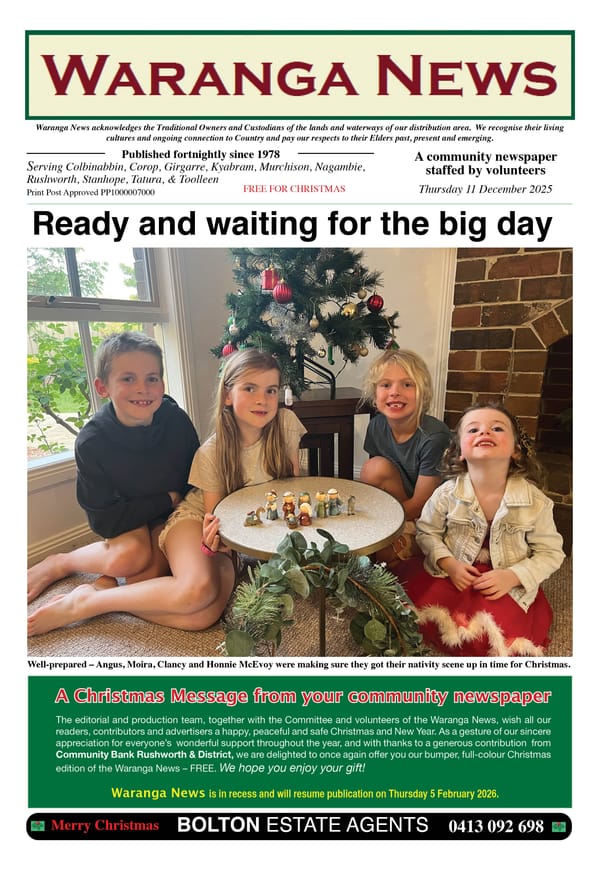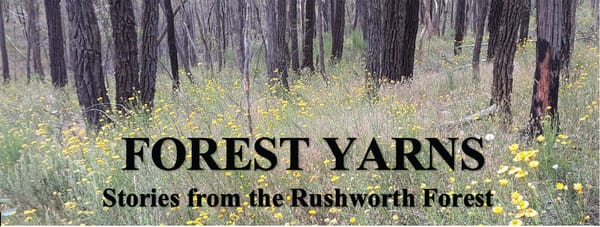40. Stone axes

Perhaps the most important tool used by the Ngurai-illum Wurrung people prior to European colonisation was the stone axe. It had a wide variety of uses, including collecting bark to make canoes, as mentioned in the previous story. They were also used to “cut wood and bark from trees to fashion wooden tools, weapons and utensils, and to pound and grind food”.1
The local area has a long history of being a source of highly prized raw materials used to make these axes. As well as being used for axe-heads, the stone was also used to make knives, as well as barbs and points for spears, all of which were vital to the survival of the Ngurai-illum Wurrung. Local stone was a valuable item traded over vast distances beyond the Waranga area.
Many axe-heads have been found in the local area. Writing to the children’s Campfire Circle page in the Weekly Times in 1934, a young Ronald Black from Moora East* claimed that “We often find aboriginal stone axes around here.”2 In 1957, the Curator of Anthropology at the National Museum of Victoria wrote that Major W J Day “who owns a fine property adjoining the timber reserve (at Reedy Lake) possesses a number of stone artifacts collected at various times from sand dunes overlooking it. He has, amongst other implements, ground edged axes which came unmistakably from Mt William.”3
MOUNT WILLIAM GREENSTONE
South of Ngurai-illum Wurrung country, Mt William (near Lancefield) is regarded as a hugely significant source of greenstone, which is well suited to the creation of stone axe-heads. The quarry was, and still is, known as Wil-im-ee Moor-ing. The custodians are members of the Wurundjeri clan of the Woiwurrung people. To put them in context, the Woiwurrung were part of the Kulin nation, along with the Waranga area’s Ngurai-illum Wurrung people, so there is no doubt that the Ngurai-illum Wurrung were very aware of the significance of Mt William, and may have travelled there on occasions.
Greenstone is the common name for a sub-volcanic rock known as diabase or diorite. It is an igneous rock, a bit like basalt, although when the volcanic lava was cooling, it cooled a bit slower than basalt did. As a result, the crystals are slightly larger. The greenstone we are talking about here did not come from a volcanic eruption, but from an intrusion. This happens when magma cools and solidifies within the crust of the planet.4
Greenstone intrusions can be exposed by subsequent erosion, which is what has happened with Mt William and at a handful of other sites in Victoria, including on the Mount Camel range in the Waranga area.
QUARRYING
Testing has revealed that quarrying at Mt William dates back about 1500 years. “Stone outcrops were fractured using fire alternated with cold water, and the stone was levered loose with fire-hardened poles. Using stone anvils as work benches, the stones would be fashioned into blanks. These were later sharpened into axe heads using abrasive sandstone to achieve a sharp edge.”5 There was no suitable sandstone at Mt William for this sort of sharpening, so the axe-heads were either traded as blanks, or taken to another site to be sharpened before use or trade.
“Researcher Isabel McBryde estimated there were 268 mining pits, eighteen of which were several metres deep surrounded by at least thirty four discrete flaking floors, with debris up to twenty metres in diameter including some featuring a central outcropping rock used as an anvil.”5 McBryde’s research also related to the Mount Camel range, which we will come back to later.
(*Moora East is not where you imagine it might be. It was due north of Rushworth, on the eastern side of the old parish of Moora – nothing to do with the settlement of Moora, west of Rushworth. There was a school (No 1991) at Moora East and the Black farm was in the very north-eastern corner of the parish of Moora on the corner of McEwen and Two Tree Roads. Most of the Rushworth township is also in the parish. Thanks for the heads up, Alan McLean)




